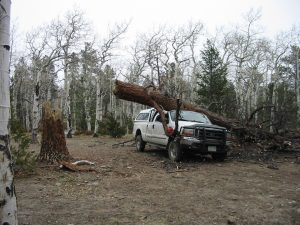3.2 Solving Percent Problems
Applications
Monitoring the use of park trails and facilities can help us allocate resources. For example, our time is better spent removing hazard trees near campgrounds that receive the highest percent of campers. So, when compiling information from campground registrations, rather than just, “How many visitors used this campground?”, we ask “What percent of the total visitors used this campground?”

Similarly, many measurements we record in the field are better understood by the public if compiled and presented as a percent. So, let’s make sure we have this down!
We use the words part and whole in a percent problem. The part is the numerator of a ratio and the whole is the denominator. So, if four fish in my sample of 12 are speckled dace, the part is 4 and the whole is 12.
A percent expresses a ratio as a fraction with 100 as the denominator. We can set up a proportion to show the relationship between a ratio and its percent.
[latex]\frac{part}{whole} = \frac{percent}{100}[/latex]
If we are missing a piece of information in this proportion, how can we find it?
Yes – cross multiplication will get us an answer!
You can just set up the proportion and cross multiply. It’s easier than memorizing the formulas below. Each of these formulas is what you get when you cross-multiply [latex]\frac{part}{whole} = \frac{percent}{100}[/latex] to find one the target element.
[latex]\frac{\text{whole} \cdot \text{percent}}{100} = \text{part}[/latex]
[latex]\frac{\text{part} \cdot \text{100}}{percent} = \text{whole}[/latex]
[latex]\frac{part}{whole}\cdot 100= percent[/latex]
Examples: Simple Percents
A) What is 12% of 58?
B) What is 108% of 60?
C) Twelve is what percent of 120?
D) Five is what percent of 3?
E) Six is 15% of what total?
F) 130 is 101% of what?
Examples: Applied Problems
A) Your plot has 12 western larch, 8 Douglas fir, and 5 grand fir. What is the ratio of western larch to all trees in the plot? What percent of the total trees are western larch?
B) Your electrofishing sample of 150 fish includes five Bull Trout. What percent of the sample are Bull Trout?
C) If 64% of the streams in the Coeur d’Alene watershed are contaminated with heavy metals, and there are 230 streams in the watershed – how many streams are contaminated?
D) If I recapture 12% of the salamanders that I originally marked, and I originally marked 78 – how many salamanders do I recapture?
E) A helicopter survey is able to count 86% of the elk present on winter range. If we count 220 elk – how many are present on winter range?
F) Three percent of Chinook Salmon stray, and return to a stream that they weren’t born in. If I find 160 salmon that weren’t born in this stream – how large is the total population?
Practice Exercises
- What is [latex]9\%[/latex] of [latex]350[/latex]?
- [latex]30\%[/latex] of [latex]75[/latex] is what number?
- Find [latex]13.5\%[/latex] of [latex]500[/latex].
- [latex]125\%[/latex] of [latex]80[/latex] is equal to what amount?
- What number is [latex]40\%[/latex] of [latex]96.5[/latex]?
- Calculate [latex]0.5\%[/latex] of [latex]450/[latex].
- Suppose you buy an electric drill with a retail price of $109.97in a city with [latex]8.5\%[/latex] sales tax. Find the amount of the tax. Round to the nearest cent, if necessary. How much do you pay in total?
Problem Set 3.2
- What is 5% of 112?
- What is 7% of 217?
- What is 118% of 6?
- Normal snowpack is 37 feet on Mt. Spokane. This years’ snowpack is at 80% of normal. How many feet of snow are on the mountain?
- Seventeen percent of trees in a burned area will become infested with pine beetles. If 3,400 trees are burned, how many will become infested?
- Rainfall this month has been 125% of normal. If normal rainfall for October is 2.1 inches, how much rainfall have we had this year?
- 45 is what percent of 115?
- 78 is what percent of 42?
- 0.86 is what percent of 2.78?
- This season, 46 of the 315 willows I planted died. What is the percent mortality for these willows?
- Last year 1,234 people visited Itasca State Park; 640 of these visitors hiked to the headwaters of the Mississippi River. What percent of visitors to Itasca State Park visited the headwaters of the Mississippi River?
- A small stand of trees is made up of 45 Douglas fir, 15 grand fir, and 28 Engelmann spruce. Grand fir makes up what percent of the stand?
- 12 is 15% of what?
- 43 is 112% of what?
- 0.8 is 7% of what?
- An aerial survey normally spots 87% of the elk herd on Tekoa Mountain. If our January survey sights 76 elk, how many are in the herd?
- During any given year 30% of Ute-Ladies tresses orchids remain dormant underground. I survey a parcel of land on the Henry’s Fork River for Ute-ladies tresses and find six plants. How many orchids are present on the site?
- Biologists conducting redd surveys generally observe 90% of the redds in a given reach of stream. Our crew counted 34 redds in a two mile reach. How many redds are present?
A "hazard tree" is a tree that has a structural defect that makes it likely to fail in whole or in part. Falling trees are an ever-present hazard when traveling or camping in the forest, yet too often we are unaware of the risks associated with defective trees. Trees are defective from age, fire and disease. (source: USFS)

